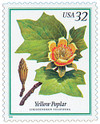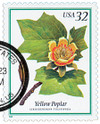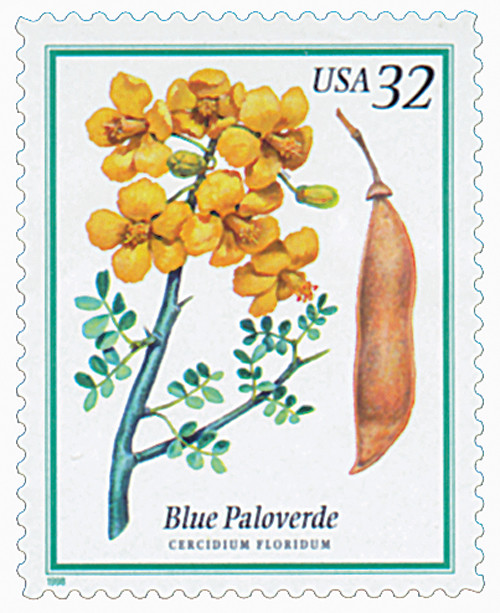
1998 32c Flowering Trees: Yellow Poplar
# 3195 - 1998 32c Flowering Trees: Yellow Poplar
$0.35 - $3.20
U.S. #3195
1998 32¢ Yellow Poplar
Flowering Trees
1998 32¢ Yellow Poplar
Flowering Trees
Issue Date: March 19, 1998
City: New York, NY
Quantity: 50,000,000
Printed By: Banknote Corporation of America
Printing Method: Lithographed
Perforations: Die Cut 11.3
Color: Multicolored
City: New York, NY
Quantity: 50,000,000
Printed By: Banknote Corporation of America
Printing Method: Lithographed
Perforations: Die Cut 11.3
Color: Multicolored
One of the largest hardwoods in the eastern United States, the yellow poplar (Liriodendron tulipifera) is more commonly known as the tulip tree. It is, in fact, the only tulip tree native to North America, and only one of two tulip trees in the world. It is not actually related to true poplars, but is rather a member of the magnolia family.
The yellow poplar is the tallest forest tree in the eastern United States. It can grow 200 feet high, and its base can be as wide as 5 to 10 feet. The tulip tree grows quickly and is resistant to diseases and pests. This tree thrives in rich, moist soil from Maine to Florida and as far west as Arkansas. It is the state tree of both Indiana and Tennessee.
The yellow poplar is important as an ornamental tree and for its timber. Its large flowers resemble tulips and are yellow to greenish-white in color with an orange band at the base. High on the tree, the flowers open during June and July, and they are a source of nectar for honeybees. The fruits are shaped like cones and contain many overlapping winged seeds. The broad green leaves change to yellow and orange in the fall. Yellow poplar wood is easily worked and is used for furniture, plywood panels, paper, boxes, and crates.
U.S. #3195
1998 32¢ Yellow Poplar
Flowering Trees
1998 32¢ Yellow Poplar
Flowering Trees
Issue Date: March 19, 1998
City: New York, NY
Quantity: 50,000,000
Printed By: Banknote Corporation of America
Printing Method: Lithographed
Perforations: Die Cut 11.3
Color: Multicolored
City: New York, NY
Quantity: 50,000,000
Printed By: Banknote Corporation of America
Printing Method: Lithographed
Perforations: Die Cut 11.3
Color: Multicolored
One of the largest hardwoods in the eastern United States, the yellow poplar (Liriodendron tulipifera) is more commonly known as the tulip tree. It is, in fact, the only tulip tree native to North America, and only one of two tulip trees in the world. It is not actually related to true poplars, but is rather a member of the magnolia family.
The yellow poplar is the tallest forest tree in the eastern United States. It can grow 200 feet high, and its base can be as wide as 5 to 10 feet. The tulip tree grows quickly and is resistant to diseases and pests. This tree thrives in rich, moist soil from Maine to Florida and as far west as Arkansas. It is the state tree of both Indiana and Tennessee.
The yellow poplar is important as an ornamental tree and for its timber. Its large flowers resemble tulips and are yellow to greenish-white in color with an orange band at the base. High on the tree, the flowers open during June and July, and they are a source of nectar for honeybees. The fruits are shaped like cones and contain many overlapping winged seeds. The broad green leaves change to yellow and orange in the fall. Yellow poplar wood is easily worked and is used for furniture, plywood panels, paper, boxes, and crates.














